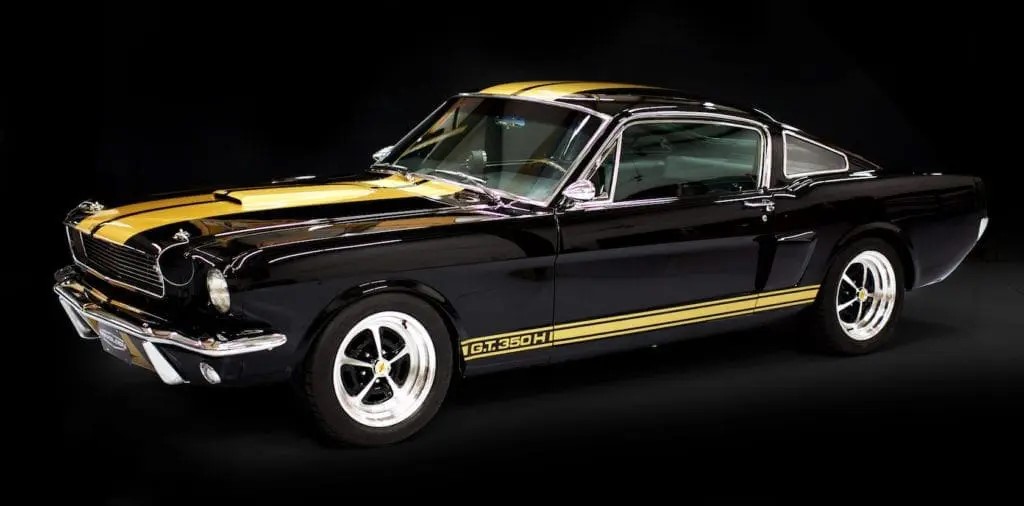
The question “What is so special about the Shelby GT?” resonates with enthusiasts and collectors alike. The Shelby GT occupies a unique place in automotive history, where brand legacy, motorsport pedigree, and engineering innovation intersect. This is not mere nostalgia but the embodiment of Carroll Shelby’s uncompromising philosophy.
More than half a century later, the Shelby GT remains the benchmark for what a Mustang can achieve when every system, including drivetrain, chassis, aerodynamics, and aesthetics, is optimized for precision and presence. The GT350 and GT500 were not cosmetic trim packages; they were performance conversions with track-bred DNA, setting them apart even today.
Born From Racing. Built for the Street.
The GT350: A Race-Ready Icon
The original Shelby GT350, launched in 1965, was not just fast; it was race-ready. Ford shipped stripped-down Mustang fastbacks to Shelby American’s Venice, California facility for transformation. A high-rpm 289 HiPo V8 with solid lifters and a Holley carburetor, paired with Koni adjustable shocks, larger brakes, and a Detroit Locker differential, turned the pony car into a competition homologation vehicle.
The GT500 and GT500KR: Redefining Power
The Shelby GT500 arrived in 1967, powered by Ford’s 428 cubic inch FE big block, delivering greater torque and smoother acceleration than the GT350. In 1968, the GT500KR introduced the 428 Cobra Jet, a high-compression, high-output engine that redefined Ford’s classic Mustang performance capabilities.
Unlike standard Mustangs, these cars featured fiberglass hoods, functional air intakes, and unique VIN sequences, marking them as Shelby-engineered vehicles. They offered superior speed and better balance compared to their Ford counterparts.
Engineering Beyond the Badge
The Shelby GT earned its reputation through measurable improvements, not marketing.
Suspension and Handling
Shelby Mustangs featured revised front roll centers, stiffer spring rates, and modified steering ratios, optimized for road courses rather than drag strips.
Weight Distribution
By eliminating rear seats and relocating batteries, the Shelby GT350 improved balance and reduced oversteer.
Aerodynamics
Rear spoilers, front splitters, and brake ducting reduced lift and enhanced cooling, serving functional purposes beyond aesthetics.
Component Matching
Shelby carefully matched final drive ratios, cam profiles, and transmission gearing to optimize torque across speed ranges.
In the modern performance landscape, these enhancements may seem standard, but from 1965 to 1968, the Shelby GT was decades ahead of most American OEM performance cars in system-level integration.
Why Rarity Isn’t Just About Numbers
Only a few thousand original Shelby GT350 and Shelby GT500 models were produced between 1965 and 1968, but scarcity is only part of their allure.
What distinguishes these cars is the quality of execution in a small-batch production environment. Shelby’s vehicles were hand-assembled, incorporating race-proven components and data from SCCA and NHRA testing. Each model evolved yearly based on real-world performance feedback.
This philosophy persists in today’s reproduction market, but only through manufacturers with rigorous engineering and OEM-grade development processes.
Modern Shelby GTs Are Built, Not Just Assembled
Revology Cars upholds the Shelby GT legacy as a licensed manufacturer of new reproduction Shelby GT350 and Shelby GT500 models. The company employs advanced product development processes mirroring those of Tier-1 OEMs.
Advanced Engineering Processes
- CAD-based structural engineering: Bodies-in-white are modeled using 3D coordinate systems for sub-millimeter tolerances.
- SPC-controlled spot welding: Each weld is validated for consistency and tensile strength, eliminating fatigue-prone seams.
- Structural adhesives: Heat-cured bonding systems enhance torsional rigidity, critical for high-horsepower platforms.
- Platform integration: Revology’s proprietary chassis is tuned for Coyote Gen 3 and Gen 5 powertrains, delivering up to 710 horsepower and 610 lb-ft of torque.
The Revology Shelby GT is more than a restoration, an engineered product, featuring optimized noise, vibration, and harshness (NVH), active thermal management, modern driveline harmonics, and production part traceability. These attributes distinguish it from most classic or kit-based builds.
Interior Innovation: Period Correct Outside, Purpose-Built Inside
Original Shelby GT models prioritized weight savings over comfort, but today’s owners demand both. Revology delivers with custom-designed interiors, built from the ground up for modern expectations.
- Custom-molded dash and console assemblies use OEM-grade polymers for durability.
- Modern CAN-bus instrumentation is integrated behind analog-style faces for authenticity.
- Dual-zone climate control ensures comfort in all conditions.
- Power steering with variable assist enhances drivability.
- Infotainment systems are concealed behind vintage panels, preserving the 1960s aesthetic.
Even the seating geometry is CAD-modeled for long-distance ergonomics while maintaining the visual style of 1960s fastbacks, delivering classic Mustang performance with contemporary refinement.
Shelby GT: A Platform That Still Dominates the Conversation
What makes the Shelby GT so special? It is not just performance or legacy but the purposeful engineering of every detail. Shelby GT models were crafted with intent, an ethos Revology Cars continues today.
These are not badge-engineered vehicles but precision-crafted machines that honor the past while exceeding modern standards.
If you are ready to own a Revology Shelby GT that looks like 1967 but drives like 2025, Revology builds it. Licensed, engineered, and meticulously crafted, these vehicles invite you to join the next chapter of the Shelby GT legend.
Explore the Revology Shelby GT lineup today.